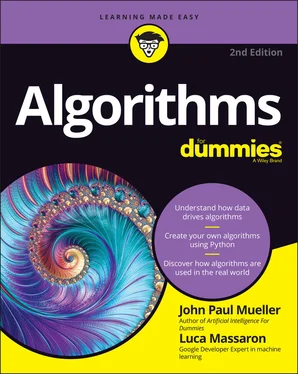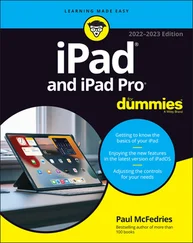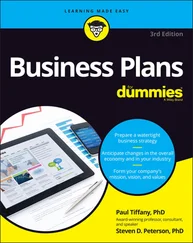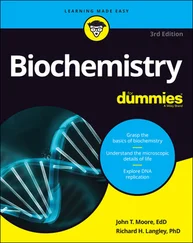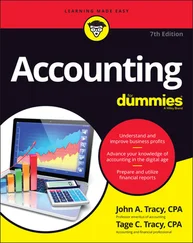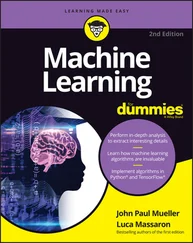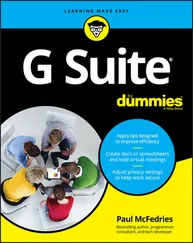John Paul Mueller - Algorithms For Dummies
Здесь есть возможность читать онлайн «John Paul Mueller - Algorithms For Dummies» — ознакомительный отрывок электронной книги совершенно бесплатно, а после прочтения отрывка купить полную версию. В некоторых случаях можно слушать аудио, скачать через торрент в формате fb2 и присутствует краткое содержание. Жанр: unrecognised, на английском языке. Описание произведения, (предисловие) а так же отзывы посетителей доступны на портале библиотеки ЛибКат.
- Название:Algorithms For Dummies
- Автор:
- Жанр:
- Год:неизвестен
- ISBN:нет данных
- Рейтинг книги:3 / 5. Голосов: 1
-
Избранное:Добавить в избранное
- Отзывы:
-
Ваша оценка:
- 60
- 1
- 2
- 3
- 4
- 5
Algorithms For Dummies: краткое содержание, описание и аннотация
Предлагаем к чтению аннотацию, описание, краткое содержание или предисловие (зависит от того, что написал сам автор книги «Algorithms For Dummies»). Если вы не нашли необходимую информацию о книге — напишите в комментариях, мы постараемся отыскать её.
Algorithms For Dummies,
Algorithms For Dummies
Algorithms For Dummies — читать онлайн ознакомительный отрывок
Ниже представлен текст книги, разбитый по страницам. Система сохранения места последней прочитанной страницы, позволяет с удобством читать онлайн бесплатно книгу «Algorithms For Dummies», без необходимости каждый раз заново искать на чём Вы остановились. Поставьте закладку, и сможете в любой момент перейти на страницу, на которой закончили чтение.
Интервал:
Закладка:
11 Index
12 About the Authors
13 Advertisement Page
14 Connect with Dummies
15 End User License Agreement
List of Illustrations
1 Chapter 2FIGURE 2-1: Complexity of an algorithm in case of best, average, and worst inpu...
2 Chapter 3FIGURE 3-1: Using Colab commands makes configuring your Notebook easy.FIGURE 3-2: The Settings dialog box helps you configure the Colab IDE.FIGURE 3-3: Customize shortcut keys for speed of access to commands.FIGURE 3-4: Colab lets you compare two files to see how they differ.FIGURE 3-5: Create a new Python 3 Notebook.FIGURE 3-6: Use this dialog box to open existing notebooks.FIGURE 3-7: When using GitHub, you must provide the location of the source code...FIGURE 3-8: Using GitHub means storing your data in a repository.FIGURE 3-9: Colab code cells contain a few extras not found in Notebook.FIGURE 3-10: Use the GUI to make formatting your text easier.
3 Chapter 4FIGURE 4-1: In the recursion process, a function continuously calls itself unti...
4 Chapter 6FIGURE 6-1: A tree in Python looks much like the physical alternative.FIGURE 6-2: Graph nodes can connect to each other in myriad ways.
5 Chapter 7FIGURE 7-1: The arrangement of keys when using a BST.FIGURE 7-2: The arrangement of keys when using a binary heap.
6 Chapter 8FIGURE 8-1: Presenting a simple undirected graph.FIGURE 8-2: Creating the directed version of the same graph.FIGURE 8-3: A mixed graph shows a mix of directed and undirected subgraphs.FIGURE 8-4: Using a weighted graph to make things more realistic.FIGURE 8-5: Seeing what a graph contains makes it easier to understand.FIGURE 8-6: Plotting the graph can help you see degree centrality with greater ...
7 Chapter 9FIGURE 9-1: Representing the example graph by NetworkX.FIGURE 9-2: The example graph becomes weighted.FIGURE 9-3: The example graph becomes weighted and directed.FIGURE 9-4: Negative edges are added to the example graph.FIGURE 9-5: A negative cycle in a graph can create problems for some algorithms...
8 Chapter 10FIGURE 10-1: A graph showing the network clusters of relationships among friend...FIGURE 10-2: Communities often contain cliques that can prove useful for SNA.FIGURE 10-3: A sample graph used for navigation purposes.
9 Chapter 11FIGURE 11-1: A strongly connected network.FIGURE 11-2: A network with a dead end in node 2.FIGURE 11-3: A network with a spider trap in nodes 4, 5, and 6.
10 Chapter 12FIGURE 12-1: Stuffing more and more transistors into a CPU.FIGURE 12-2: How sampling from a bucket works.FIGURE 12-3: An example of windowing a stream of DNA data.FIGURE 12-4: Adding a single element to a bit vector.FIGURE 12-5: Adding a second element can cause collisions.FIGURE 12-6: Locating an element and determining that it exists means searching...FIGURE 12-7: Testing membership of a website using a Bloom filter.FIGURE 12-8: Counting only leading zeros.FIGURE 12-9: How values are updated in a Count-Min Sketch.
11 Chapter 13FIGURE 13-1: Associative and commutative properties allow parallelism.FIGURE 13-2: A schema representing a computing cluster.FIGURE 13-3: Mapping a list of numbers by a square function.FIGURE 13-4: Reducing a list of numbers to its sum.FIGURE 13-5: An overview of the complete MapReduce computation.
12 Chapter 14FIGURE 14-1: A Huffman tree and its symbolic table of conversion.
13 Chapter 15FIGURE 15-1: The sets of P, NP, NP-complete and NP-hard problems.FIGURE 15-2: From a balanced tree (left) to an unbalanced tree (right).
14 Chapter 16FIGURE 16-1: Cities represented as nodes in a weighted graph.FIGURE 16-2: Transforming Saturday into Sunday.FIGURE 16-3: Highlighting what transformations are applied.
15 Chapter 17FIGURE 17-1: A histogram of a normal distribution.FIGURE 17-2: A histogram of a uniform distribution.FIGURE 17-3: Displaying the results of a Monte Carlo simulation.FIGURE 17-4: Displaying the results of a Monte Carlo simulation on quick select...FIGURE 17-5: Displaying Monte Carlo simulations as input grows.
16 Chapter 18FIGURE 18-1: Switching ending trips in a TSP problem may bring better results.FIGURE 18-2: Local search explores the landscape by hill climbing.FIGURE 18-3: An 8-queen puzzle solved.FIGURE 18-4: Symbols and truth tables of logic operators AND, OR, and NOT.FIGURE 18-5: The number of unsatisfiable clauses decreases after random adjustm...FIGURE 18-6: Execution is speedier because the starting point is better.
17 Chapter 19FIGURE 19-1: Looking where the objective function is going to touch the feasibl...FIGURE 19-2: Wondering which vertex is the right one.
18 Chapter 20FIGURE 20-1: A and B are points on a map’s coordinates.FIGURE 20-2: A maze representing a topological map with obstacles.FIGURE 20-3: An intricate maze to be solved by heuristics.
Guide
1 Cover
2 Title Page
3 Copyright
4 Table of Contents
5 Begin Reading
6 Index
7 About the Authors
Pages
1 i
2 ii
3 1
4 2
5 3
6 4
7 5
8 7
9 8
10 9
11 10
12 11
13 12
14 13
15 14
16 15
17 16
18 17
19 18
20 19
21 20
22 21
23 22
24 23
25 24
26 25
27 26
28 27
29 28
30 29
31 30
32 31
33 32
34 33
35 34
36 35
37 36
38 37
39 38
40 39
41 40
42 41
43 42
44 43
45 44
46 45
47 46
48 47
49 48
50 49
51 50
52 51
53 52
54 53
55 54
56 55
57 56
58 57
59 59
60 60
61 61
62 62
63 63
64 64
65 65
66 66
67 67
68 68
69 69
70 70
71 71
72 72
73 73
74 74
75 75
76 76
77 77
78 78
79 79
80 80
81 81
82 82
83 83
84 84
85 85
86 86
87 87
88 88
89 89
90 90
91 91
92 92
93 93
94 94
95 95
96 96
97 97
98 98
99 99
100 100
101 101
102 102
103 103
104 104
105 105
106 106
107 107
108 108
109 109
110 110
111 111
112 112
113 113
114 114
115 115
116 117
117 118
118 119
119 120
120 121
121 122
122 123
123 124
124 125
125 126
126 127
127 128
128 129
129 130
130 131
131 132
132 133
133 134
134 135
135 136
136 137
137 139
138 140
139 141
140 142
141 143
142 144
143 145
144 146
145 147
146 148
147 149
148 150
149 151
150 152
151 153
152 154
153 155
154 156
155 157
156 158
157 159
158 161
159 162
160 163
161 164
162 165
163 166
164 167
165 168
166 169
167 170
168 171
169 172
170 173
171 174
172 175
173 176
174 177
175 178
176 179
177 180
178 181
179 182
180 183
181 184
182 185
183 186
184 187
185 188
186 189
187 190
188 191
189 192
190 193
191 194
192 195
193 196
194 197
195 198
196 199
197 200
198 201
199 202
200 203
201 204
202 205
203 207
204 208
205 209
206 210
207 211
208 212
209 213
210 214
211 215
212 216
213 217
214 218
215 219
216 220
217 221
218 222
219 223
Читать дальшеИнтервал:
Закладка:
Похожие книги на «Algorithms For Dummies»
Представляем Вашему вниманию похожие книги на «Algorithms For Dummies» списком для выбора. Мы отобрали схожую по названию и смыслу литературу в надежде предоставить читателям больше вариантов отыскать новые, интересные, ещё непрочитанные произведения.
Обсуждение, отзывы о книге «Algorithms For Dummies» и просто собственные мнения читателей. Оставьте ваши комментарии, напишите, что Вы думаете о произведении, его смысле или главных героях. Укажите что конкретно понравилось, а что нет, и почему Вы так считаете.
